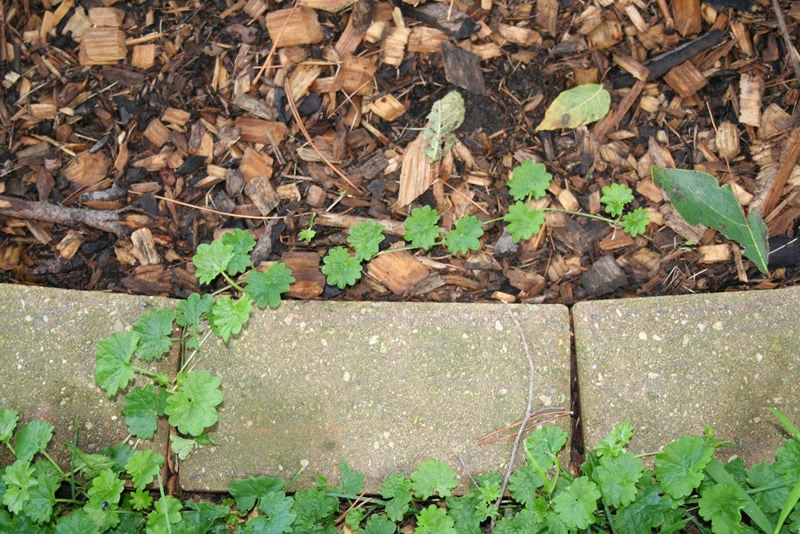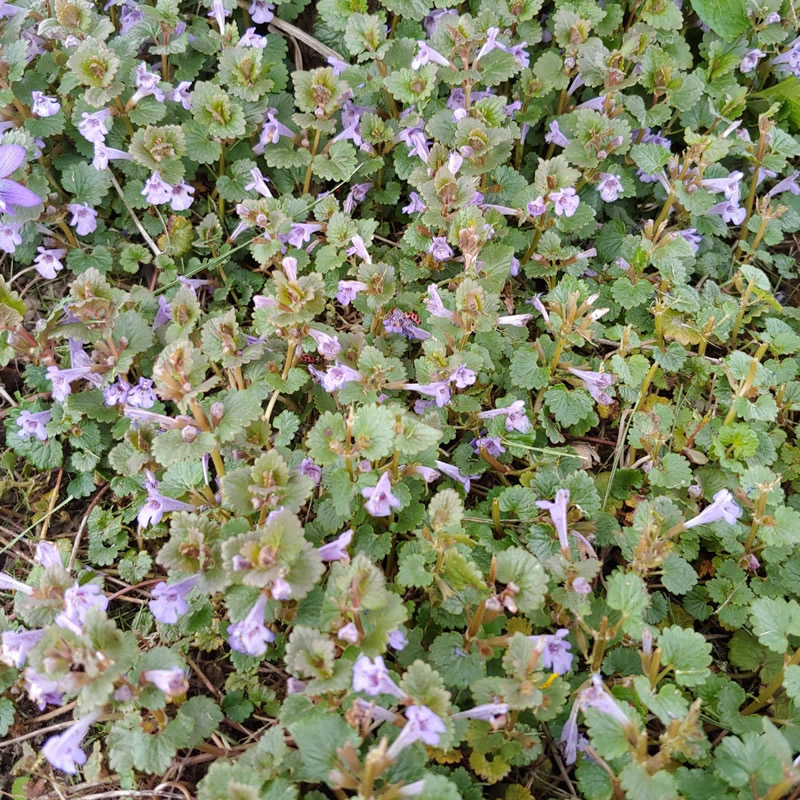Issue 3, May 20, 2020
Ground Ivy
Ground ivy (Glechoma hederacea)is a low growing perennial weed commonly found in lawns and landscape beds. It is commonly referred to Creeping Charlie but is also known as gill-over-the-ground, cats-foot, and field balm. It is sometimes sold in hanging baskets and as a groundcover. It actually makes a fantastic groundcover, but the problem with this plant is that it doesn’t behave or know it’s boundaries and will attempt to cover the county if you let it. Also, this weed is tough to control.

Ground ivy moving from the lawn into a neighboring landscape bed – photo by Michelle Wiesbrook
Ground ivy spreads aggressively to form dense patches by both seeds and creeping stems that root at the nodes. The leaves are 1/2 to 1-1/2 inches in diameter. They are round or kidney shaped with rounded toothed margins and are medium to dark green in color. Leaves can be smooth or hairy but they are found opposite each other on long petioles. Ground ivy plants emit a strong mint-like odor when crushed, mowed, or simply walked upon. Some love this smell, while some hate this smell. Stems are square (four-sided). The flowers are small, lavender to purplish blue, funnel shaped, and clustered in leaf axils. They appear from April to June. This weed normally occurs in shaded sites with poorly drained (think plenty of moisture), fertile soils, but can spread into sunny areas.

A dense population of ground ivy – photo by Michelle Wiesbrook
When ground ivy first appears, it can be easily confused with henbit, a winter annual. However, henbit leaves do not appear opposite one another in pairs as that of ground ivy does and henbit is more erect in its growth. Slender speedwell and common mallow can look similar ground ivy but both have round rather than square stems. Purple blooming weeds are discussed in this HYG article at: http://hyg.ipm.illinois.edu/article.php?id=773.
Ground ivy can be difficult to control. For best results, alter the preferred growing conditions and provide competition. If the area is bare soil, it’s a good idea to plant something that competes well with weeds. Choose plants that are also well suited for these growing conditions, such as vinca, English ivy, pachysandra, or hosta. If the area is struggling turf, adjust your cultural practices to improve turf health and density (that is, increase mowing height to 3 inches or more, fertilize and overseed in the fall, water properly, etc.). Proper turfgrass selection is also essential for obtaining thick, healthy turf. Finally, shady areas may be brightened with a little pruning. Keep in mind that although shade is preferred, creeping Charlie has been known to move into full-sun areas.

Ground ivy in bloom – photo by Michelle Wiesbrook
Hand-pulling can work well as a quick, short-term fix. A neighbor of mine uses a dethatching rake to pull up this plant. Be sure to remove uprooted plants to prevent re-rooting. Unfortunately, the extensive root system of rhizomes is very difficult to completely remove by hand-pulling.
Herbicides may be used. In landscape beds, our research colleagues at Purdue University report that limited control is reached with preemergent herbicides but flumioxazin and isoxaben may be tried. For postemergent herbicide options, they have seen the best success with sulfentrazone and sulfosulfuron.
In cool-season grasses, research has shown that the best results were with the active ingredients, fluroxypyr and triclopyr. Both work well as standalone products and may indeed work better than when as part of a two-, three-, or four-way product because the percentage of these ingredients is higher. Combination products of these two alone should be effective as well. Applications should be made at bloom time or just after. For best results, a second application should be applied 3 to 4 weeks later. For complete control, 1 or 2 fall applications will likely be needed. Ground ivy is persistent! These products can provide injury to sensitive plants. When using any pesticide, be sure to carefully read and follow all label directions. In turfgrass, preemergence products provide little control for this perennial weed. Homemade mixtures containing boron (Borax) are NOT recommended as results are inconsistent and long-term damage can result to the soil. For more on this topic, please see this HYG article at: http://hyg.ipm.illinois.edu/pastpest/200114e.html.
For more information on the best ways to control broadleaf weeds in turf, check out this past HYG article at: http://hyg.ipm.illinois.edu/article.php?id=967.
Author:
Michelle Wiesbrook